ESL Describing People Vocabulary
This page is all about the ESL describing people vocabulary that you will need when you have to talk about someone, describe them or explain what someone looks like. This is mainly about what their body looks like, if you need to explain what they are wearing you can use the ESL clothes vocabulary page.
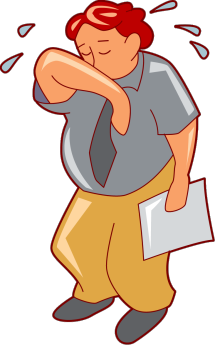
The first part of this page has a vocabulary list that has many words, their definition and their part of speech. All of these words will be useful when you need to describe someone. There is then a set of flashcards that you can download that have all the ESL describing people vocabulary words and definition on them. There is then a recording of the vocabulary being spoken by a native English speaker so you can hear how the words should be pronounced.
The second part of the page has exercises and tasks for you to do that will test how much of the ESL describing people vocabulary you can remember. These tasks are important as you need to be able to remember the words and use them. The three exercises are as follows:
- Chose the correct definition that matches a word.
- Chose the correct word that matches a definition.
- Chose the correct word that matches a picture.
ESL Describing People Vocabulary List with Definitions
Below is the ESL describing people vocabulary list. The list has many useful words as well as their definitions and the part of speech where it is used. This list can be used as a reference so you can look up words you do not know, or you can try to learn all the words so you do not need to look at it again. Following the list are some ESL describing people flashcards you can download and then a couple of recordings of the ESL describing people vocabulary being spoken by a native English speaker.
Accent: The way a person speaks and says words. (noun)
African: To come from Africa or to have the characteristic of someone from Africa. (adjective)
Age: The time reached in years. (noun)
American: To come from the North or South American continents or to come from the United States of America. (adjective)
Ancestor: A family member from long ago. (noun)
Anxiety: A state of being worried. (noun)
Anxious: To be upset or bothered by events which maybe beyond your control. (adjective)
Asian: To come from Asia or to have the characteristics of someone from Asia. (adjective)
Attractive: To be good to look at and to have a nice appearance. (adjective)
Average: To be in the middle, to not be short or tall, or not long or short. (adjective)
Bald: An absence of hair. (adjective)
Beard: The hair that grows on the face and around the jaw. (noun)
Beautiful: To be lovely, very good to see. (adjective)
Black: To have dark coloured skin. (adjective)
Blond: To have pale skin and yellow hair. (adjective)
Body-building: Activities to increase muscle development so that the muscles become visible. (noun)
Bones: The hard parts that create the human skeleton. (noun)
Boney: To have a big body, as way of saying someone might be a bit fat. (adjective)
Cheeks: The sides of the face below the eyes. (noun)
Chin: The bottom part of the jaw below the mouth. (noun)
Cross: To be annoyed, upset. (adjective)
Curly: To be wavy, not straight. (adjective)
Devious: To perform in an underhand way. (adjective)
Drab: To be extremely dull, dark, uninteresting. (adjective)
Emotion: An expression of the way we feel. (noun)
Encourage: To support, often using words. (verb)
European: To come from Europe. (adjective)
Evil: To be bad, harmful and nasty. (adjective)
Excess: For there to be too much of something. (adjective)
Eyebrows: The thin strips of hair above the eyes. (noun)
Eyes: The parts of the face that enable us to see. (noun)
Fair-hair: To have light coloured hair. (adjective)
Fat: To be overweight. (adjective)
Features: The parts of our anatomy that are observable. (noun)
Fine: To be very thin, delicate. (adjective)
Forehead: The part of the head below the hair and above the eyebrows. (noun)
Fragile: To be easily broken, delicate. (adjective)
Fringe: The hair that hangs down and covers the forehead. (noun)
Generous: To give without thinking about oneself. (adjective)
Ginger: To have orange or red coloured hair. (adjective)
Good-looking: To be attractive and nice to see. (adjective)
Grumpy: To be cross in temperament and always complaining. (adjective)
Hair: The threads that cover on head and other body parts. (noun)
Handsome: To be attractive and nice to see, used to describe a man and not a woman. (adjective)
Happy: To be full of joy, pleasant. (adjective)
Height: A person’s size vertically. (noun)
Imprint: To make a mark or leave a mark. (verb)
Jaw: The bottom edge of the face. (noun)
Joints: The place where different bones meet and can move. (noun)
Kind: To be nice and thoughtful to others. (adjective)
Length: The size of someone/thing, possibly horizontally. (noun)
Lips: The edges of the mouth. (noun)
Long: A measurement of distance, the opposite of short. (adjective)
Mark: A distinguishing spot. (noun)
Medium: To be in the middle, to not be big or small. (adjective)
Mental: The use of the brain's thought processes. (adjective)
Middle-aged: The time when people are between about 45-65 years old. (adjective)
Mole: A small dark mark on the surface of the skin. (noun)
Moustache: The hair under the nose and above the top lip. (noun)
Mouth: The opening in the face that sound comes out of and food goes into. (noun)
Move: To be active, not still. (verb)
Neck: The part of the body joining the head to the torso. (noun)
Nervous: To be lacking confidence. (adjective)
Nose: A feature in the middle of the face. (noun)
Obese: To be extremely fat and unhealthy. (adjective)
Old: To have lived a long time. (adjective)
Overweight: To have too much body fat for the skeleton to support with comfort. (adjective)
Physical: To be active, moving about. (adjective)
Plump: To be slightly fat and just a little overweight. (adjective)
Posture: A way of standing, holding the body in an erect position. (noun)
Pretty: To be nice to look at. (adjective)
Puberty: An age at which physical development takes place. (noun)
Recognise: To remember someone/thing. (verb)
Sad: A feeling of unhappiness. (adjective)
Sadness: To be troubled, anxious or miserable. (noun)
Scar: A physical mark on the skin. (noun)
Scatter-brained: To be unthinking, unclear in action or to forget things easily. (adjective)
Scruffy: To have an untidy appearance. (adjective)
Short: To be low down, not very high, the opposite of tall. (adjective)
Size: A defined shape and height. (noun)
Skin: The covering that protects the body. (noun)
Skinny: To be very thin and to look unhealthy. (adjective)
Slim: To not have any extra fat on a body. (adjective)
Smart: To be cleaver and good at using your brain. (adjective) To look good and wear smart clothes. (adjective)
Stamina: The ability to continue physical exercise for long periods of time. (noun)
Stooped: To be bent, not straight. (adjective)
Straight: To stand upright. (adjective)
Stride: The distance between steps. (noun)
Strong: To be powerful and have large muscles. (adjective)
Supple: To be flexible and able to bend in lots of different ways. (adjective)
Tall: To be high up, to be very high, the opposite of short. (adjective)
Tattoo: A permanent inked mark or pattern drawn on the skin. (noun)
Teeth: The hard objects in a mouth that are used for eating/chewing food. (noun)
Thick: To be chunky, the opposite of thin. (adjective)
Thin: To be slight, the opposite of thick. (adjective)
Tone: The sound of something. (noun)
Torso: The main part of the body that the legs, arms and neck are attached to. (noun)
Tubby: To be a little bit fat. (adjective)
Ugly: Not nice to view, the opposite of pretty. (adjective)
Voice: A way of communicating, speaking or singing. (noun)
Walk: To move using legs. (verb)
Weak: To lack power and the ability to do something, the opposite of strong. (adjective)
Weight: A description of how heavy something or someone is. (noun)
Well-built: To have a big body that might also be a bit fat. (adjective)
Well-dressed: To look good and wear smart clothes. (adjective)
White: To have pale skin. (adjective)
Worry: To be anxious and troubled. (verb)
Wrinkles: The lines on the skin that are most visible on the face. (noun)
Young: To have lived only a short time, to not be very old. (adjective)
Vocabulary Flashcards for Describing People Words
You can download the following ESL describing people flashcards so you can use them when you are not able to connect to the Internet. To do this just click the picture or link and then there will be an option to save them to your computer.
ESL describing people flashcards
Spoken Describing People Vocabulary
Next there are two recordings of the ESL describing people vocabulary being spoken by a native English speaker. By listening to them you will be able to hear the correct pronunciation. The first recording you can just listen to, while for the second recording you can see the ESL describing people vocabulary flashcards from above at the same time as the word is spoken. Listen to the recordings as many times as you need so you can remember the correct way to say the words.
ESL Describing People Vocabulary Exercises
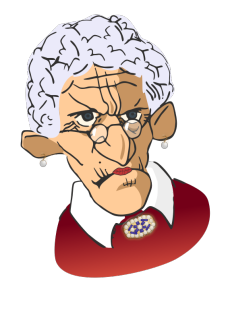
Exercise 1 – Correct Definition
For the first ESL describing people vocabulary activity you need to decide which of the definitions (A-D) in each question matches the given word. When you have finished you can use the get score button to see the correct answers.
ESL Describing People Vocabulary Definitions
Choose the correct definition for the describing people vocabulary in this quiz.
Exercise 2 – Correct Meaning
In the second ESL describing people vocabulary task you need to choose the word (A-D) in each question that matches the given definition. At the end you can again see how many you got correct by clicking the get score button.
ESL Describing People Vocabulary Identification of Meaning
Choose the word that matches the definition given in each of the five questions in this quiz.
Exercise 3 – Identify Picture
In the third ESL describing people vocabulary exercise you need to look at the following pictures and then decide which word (A-D) in each question matches the indicted picture. Then you can use the get score button to see how many you got correct.
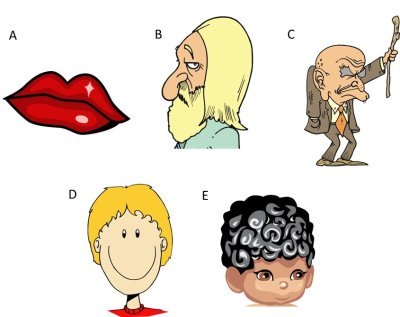
ESL Describing People Vocabulary Picture Descriptions
Identify the best description for each of the images (A-E) given above that correspond to the five questions in this quiz.
Other Pages about Describing People that You Might Like
ESL Describing People Conversations
ESL Describing People Listening
ESL Describing People Reading
ESL Describing People Writing
ESL 4u home › Vocabulary › Describing people


|
|
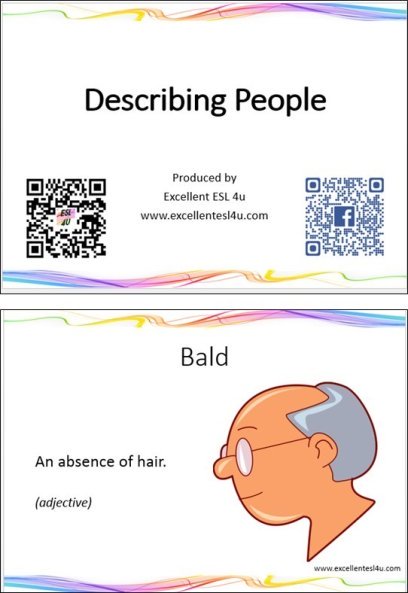
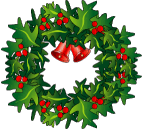
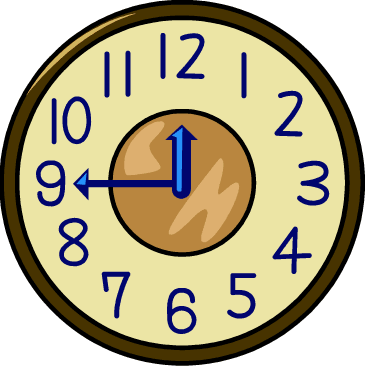
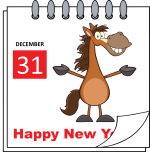
New! Comments
Have your say about what you just read! Leave me a comment in the box below.